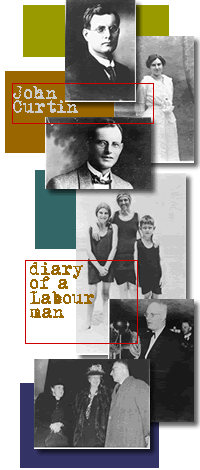


John Curtin was elected leader of the Federal Parliamentary Labor Party on 1 October 1935. He was immediately beset with challenges at home and abroad. On-going divisions in the Labor Party were temporarily resolved after conferences which resulted in the party rescinding its expulsion of Jack Lang and his followers. However, by May 1940, Lang’s supporters in the House of Representatives had again broken away. Mussolini launched an invasion of Abyssinia soon after Curtin became leader, and in December 1936 the King abdicated. Robert Menzies became Prime Minister after the death of Joe Lyons in April 1939, and on 3 September 1939 Australia was at war with Germany.
Curtin had little time for leisure in this period (though intriguingly he takes ‘a fortnight’s leave on account of urgent private affairs’ in November 1938). Normal parliamentary duties had to be managed along with his heavy workload as Leader of the Party. He travelled extensively around Australia, attending and speaking at numerous conferences, making broadcasts, and assisting candidates in state and federal elections and by-elections, including undertaking wide-ranging campaign tours for the federal elections of 1937 and 1940. Against this backdrop of fatiguing and unrelenting work, Curtin’s health suffered and reports of his various illnesses are more frequent after 1938. In addition, he had to cope with personal losses, including the deaths of his mother (1938), colleague David Watson, manager of the Westralian Worker (also in 1938), his friend May Holman MLA (1939), and his one-time mentor Frank Anstey (1940).
Elsie Curtin and their children no longer spent long periods in Canberra, although Elsie visited regularly and Curtin returned to WA on at least twenty occasions in the years 1935 to 1941. Between visits, he remembered family birthdays and wedding anniversaries, and even managed some fatherly guidance, in letters which show his love and concern for his wife and children.
Reports in key newspapers such as the Sydney Morning Herald andCurtin’s speeches in parliament and as Leader of the ALP reveal his growing importance as a national identity. Minutes of the frequent caucus meetings which he chaired provide insights into his leadership style and the internal politics of the party. They also illustrate Caucus’s growing respect for his capacity as a leader. The Westralian Worker proved invaluable for its coverage of his visits to WA, providing detail which was not evident in other sources.
We invite you to explore the diary of Curtin’s life as Leader of the Opposition from 1935-1941.
We invite you to explore the diary of Curtin's life as Leader of the Opposition from 1935 to 1941.
 |
 |
||||||||||||||